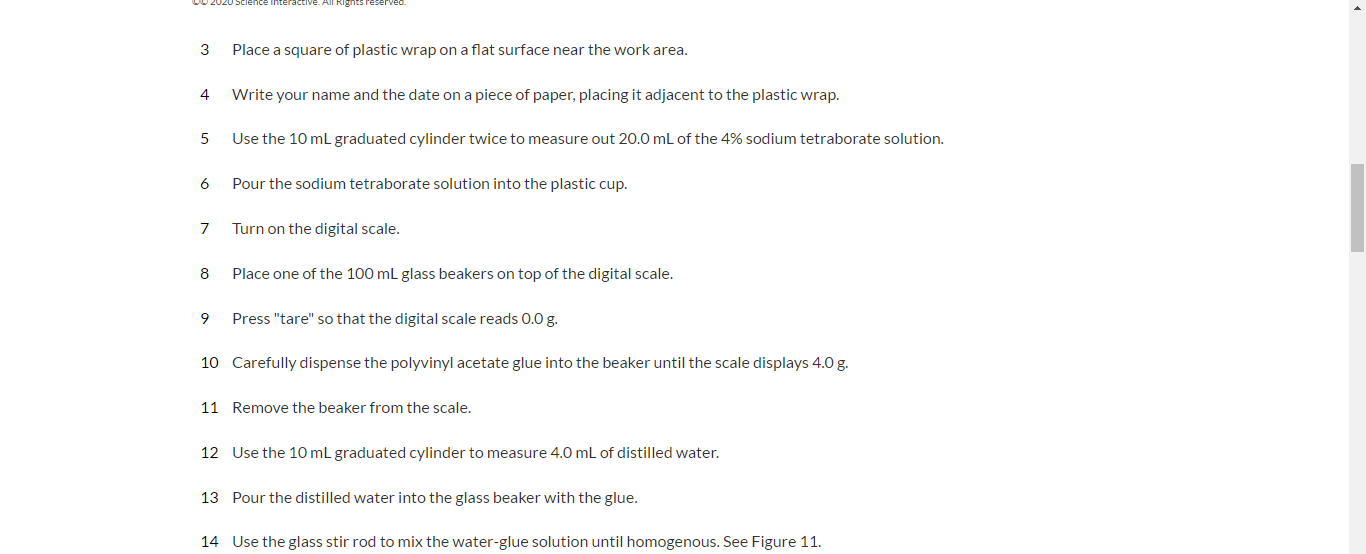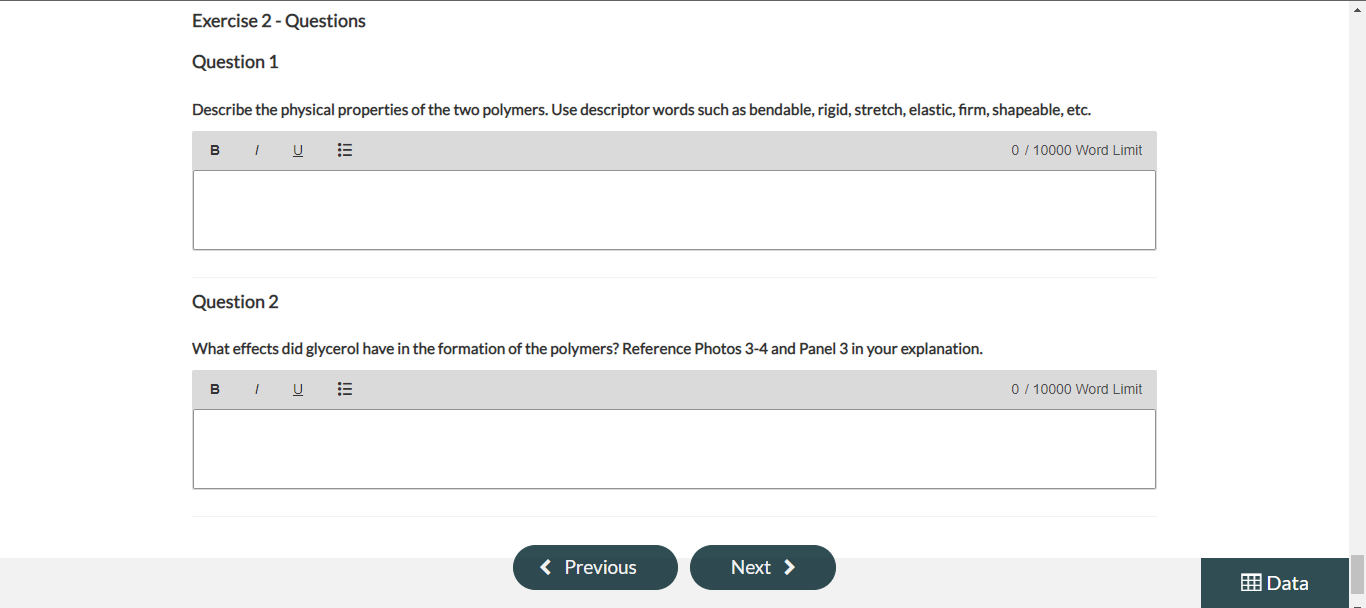



 Lab Polymers Exercise 2: Starch Glycerol Polymer
Lab Polymers Exercise 2: Starch Glycerol Polymer
Exercise 1 PVA-Borax Polymer In this exercise you will observe the effects of length of exposure to a plasticizer on a polymer's physical properties over time. 1 Put on your goggles and gloves. 2 Gather a roll of plastic wrap, a piece of paper, the 10 ml graduated cylinder, the 4% sodium tetraborate solution, two plastic cups, the digital scale, two 100 ml beakers, the polyvinyl acetate glue, the glass stir rod, and distilled water, and place them on a clean work surface. 3 Place a square of plastic wrap on a flat surface near the work area. 4 Write your name and the date on a piece of paper, placing it adjacent to the plastic wrap. 5 Use the 10 ml graduated cylinder twice to measure out 20.0 mL of the 4% sodium tetraborate solution. 6 Pour the sodium tetraborate solution into the plastic cup. 7 Turn on the digital scale. 8 Place one of the 100 mL glass beakers on top of the digital scale. 9 Press "tare" so that the digital scale reads 0.0 g. 10 Carefully dispense the polyvinyl acetate glue into the beaker until the scale displays 4.0 g. 11 Remove the beaker from the scale. 12 Use the 10 ml graduated cylinder to measure 4.0 mL of distilled water. 13 Pour the distilled water into the glass beaker with the glue. 14 Use the glass stir rod to mix the water-glue solution until homogenous. See Figure 11. 16 Do not mix, but use the glass stir rod to lightly turn over and immediately retrieve the white polymer from the sodium tetraborate solution. 17 Stretch the polymer out on the piece of plastic wrap, noting its initial texture and flexibility. 18 Record your observations in Panel 1. 19 Take a photo of the resulting polymer, making sure your name and the data appear in the photo. 20 Upload the image of the polymer to Photo 1. 21 Repeat steps 3-15. 22 Set and start a timer for 30 seconds, leaving the polymer undisturbed during this time. 23 Use the glass stir rod to gently combine the polymer with the remaining sodium tetraborate solution so that the white mass absorb as much of the sodium tetraborate as possible. 20 Upload the image of the polymer to Photo 1. 21 Repeat steps 3-15. 22 Set and start a timer for 30 seconds, leaving the polymer undisturbed during this time. 23 Use the glass stir rod to gently combine the polymer with the remaining sodium tetraborate solution so that the white mass absorb as much of the sodium tetraborate as possible. Exercise 2 - Questions Question 1 Describe the physical properties of the two polymers. Use descriptor words such as bendable, rigid, stretch, elastic, firm, shapeable, etc. B / US 0 / 10000 Word Limit Question 2 What effects did glycerol have in the formation of the polymers? Reference Photos 3-4 and Panel 3 in your explanation. 0 / 10000 Word Limit Data Exercise 1 PVA-Borax Polymer In this exercise you will observe the effects of length of exposure to a plasticizer on a polymer's physical properties over time. 1 Put on your goggles and gloves. 2 Gather a roll of plastic wrap, a piece of paper, the 10 ml graduated cylinder, the 4% sodium tetraborate solution, two plastic cups, the digital scale, two 100 ml beakers, the polyvinyl acetate glue, the glass stir rod, and distilled water, and place them on a clean work surface. 3 Place a square of plastic wrap on a flat surface near the work area. 4 Write your name and the date on a piece of paper, placing it adjacent to the plastic wrap. 5 Use the 10 ml graduated cylinder twice to measure out 20.0 mL of the 4% sodium tetraborate solution. 6 Pour the sodium tetraborate solution into the plastic cup. 7 Turn on the digital scale. 8 Place one of the 100 mL glass beakers on top of the digital scale. 9 Press "tare" so that the digital scale reads 0.0 g. 10 Carefully dispense the polyvinyl acetate glue into the beaker until the scale displays 4.0 g. 11 Remove the beaker from the scale. 12 Use the 10 ml graduated cylinder to measure 4.0 mL of distilled water. 13 Pour the distilled water into the glass beaker with the glue. 14 Use the glass stir rod to mix the water-glue solution until homogenous. See Figure 11. 16 Do not mix, but use the glass stir rod to lightly turn over and immediately retrieve the white polymer from the sodium tetraborate solution. 17 Stretch the polymer out on the piece of plastic wrap, noting its initial texture and flexibility. 18 Record your observations in Panel 1. 19 Take a photo of the resulting polymer, making sure your name and the data appear in the photo. 20 Upload the image of the polymer to Photo 1. 21 Repeat steps 3-15. 22 Set and start a timer for 30 seconds, leaving the polymer undisturbed during this time. 23 Use the glass stir rod to gently combine the polymer with the remaining sodium tetraborate solution so that the white mass absorb as much of the sodium tetraborate as possible. 20 Upload the image of the polymer to Photo 1. 21 Repeat steps 3-15. 22 Set and start a timer for 30 seconds, leaving the polymer undisturbed during this time. 23 Use the glass stir rod to gently combine the polymer with the remaining sodium tetraborate solution so that the white mass absorb as much of the sodium tetraborate as possible. Exercise 2 - Questions Question 1 Describe the physical properties of the two polymers. Use descriptor words such as bendable, rigid, stretch, elastic, firm, shapeable, etc. B / US 0 / 10000 Word Limit Question 2 What effects did glycerol have in the formation of the polymers? Reference Photos 3-4 and Panel 3 in your explanation. 0 / 10000 Word Limit Data




 Lab Polymers Exercise 2: Starch Glycerol Polymer
Lab Polymers Exercise 2: Starch Glycerol Polymer





